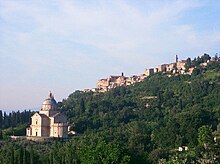Madonna di San Biagio
The church of Madonna di San Biagio , located about one kilometer south-west below the city fortifications of Montepulciano , is one of the most impressive central buildings of the Tuscan Renaissance . It lies in the open field at the end of a cypress avenue and served as a pilgrimage church .
Building history
The travertine church, consecrated to Saint Blaise , was built from 1519 to 1540 based on designs by the Florentine architect Antonio da Sangallo the Elder on the relics of the medieval Pieve di San Biagio.
The structure of the church goes back to Bramante's (not executed) plan for St. Peter's Basilica in Rome (1506) and Giuliano da Sangallo's ideas for the church of Santa Maria delle Carceri in Prato from 1484, which were also not realized in this form.
Exterior construction
San Biagio is built on the plan of a Greek cross, the crossing is spanned with a dome. The only decorations in the basement are Doric pilasters . The entrance portals are crowned by massive triangular gables. On the floor above these elements are repeated in an ionic order. Above that, there are triangular gables on all four arms of the cross, each with a simple oculus in the middle. What was new for the Italian Renaissance at the beginning of the 16th century was that on the floor directly below the dome, in the so-called tambour , pilasters and niches alternate, as Bramante had proposed for St. Peter's Basilica; this antique tree motif is also repeated in the interior.
Either four or - according to other information - only two towers were planned between the cross arms, of which only the western one in the north has been completed and the eastern one has only been begun to a limited extent. In the completed four-storey tower, the ancient order - Doric, Ionic, Corinthian and composite - is precisely adhered to in the pilasters . Only in the south was an apse placed in the central room, which served as a sacristy . The building itself is reduced to simple geometric shapes - cuboids, cylinders and hemispheres - with antique dividing elements. The Madonna di San Biagio church is a good example of a central building from the High Renaissance.
inner space
The walls are only structured by flat pilasters. This type of structure and the position of the church, which is free on all sides, corresponds to the ideal of the time for a church building, as it could usually only be realized in smaller buildings within cities.
The main difference between the exterior and interior is the clear direction that the church receives from the protruding apse and the stand-alone facade tower, while the interior is a pure central space. The interior has an almost square floor plan, which is only extended by four short transverse arms. The apse protruding from the outside is 'tied off' on the inside, so that the impression of a uniform central space is created.
A look into the dome area shows that the tambour floor is structured in the same way on the inside as it is on the outside, a further indication of the relationship between church architecture and the decorative forms of classical ancient architecture.
In this interior, more than anywhere else, you can get an impression of what the ancient Roman basilicas looked like inside. The basic structure of the church as a central building comes from Florence, but the interior elevation is new for the time, but historically very old. The Sangallo brothers drew the ancient basilica of Aemilia in Rome meticulously before it was built in the first years of the 16th century. was demolished. "Antonio has not only taken from her the most striking stylistic feature, namely the compound [...] a pilaster and a sunken column in all corners, but also the design of the individual elements themselves" , d. H. the rosettes in the capitals, the Doric frieze and the finials in the girders. The pair of pilasters and columns can also be found on all floors of the bell tower.
On the right-hand podium there is an organ from 1781, built by the organ builder Alamanno Contucci. The organ is in a wooden case, which is lavishly painted in a marble look. The purely mechanical instrument 16 registers on a manual movement with a range of 47 notes with a short first octave, and pedal with 8 notes; the pedal is permanently linked to the manual; a ninth pedal button is connected to two pipes that sound the “Timpano” effect register. The stops are arranged in two horizontal rows to the right of the manual.
|
|
|
||||||||||||||||||||||||||||||||||||||
literature
- Bertrand Jestaz : The Art of the Renaissance. Freiburg-Basel-Vienna 1985. p. 535.
- Georg Satzinger : Antonio da Sangallo the Elder and the Madonna di San Biagio near Montepulciano (= Tübingen studies on archeology and art history. Vol. 11). Wasmuth, Tübingen 1991, ISBN 3-8030-1910-9 (also: Tübingen, University, dissertation, 1988).
Web links
- Description with pictures (Italian)
Individual evidence
- ↑ Jestaz, Bertrand: The art of the Renaissance. Freiburg-Basel-Vienna. 1985, p. 535
- ↑ Information on the organ ( Memento from November 7, 2017 in the Internet Archive )
Coordinates: 43 ° 5 ′ 17 ″ N , 11 ° 46 ′ 29 ″ E




